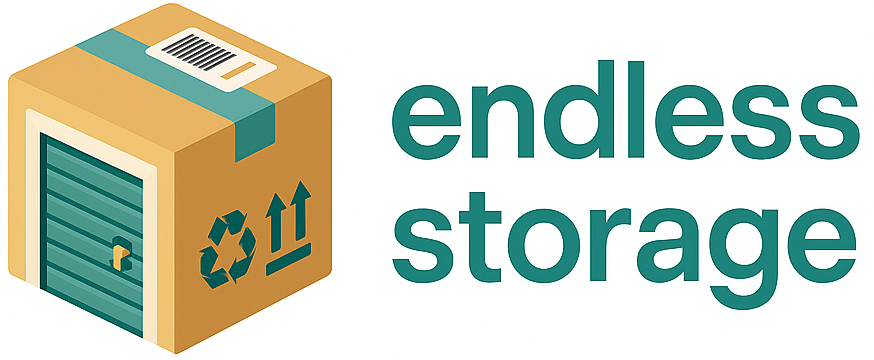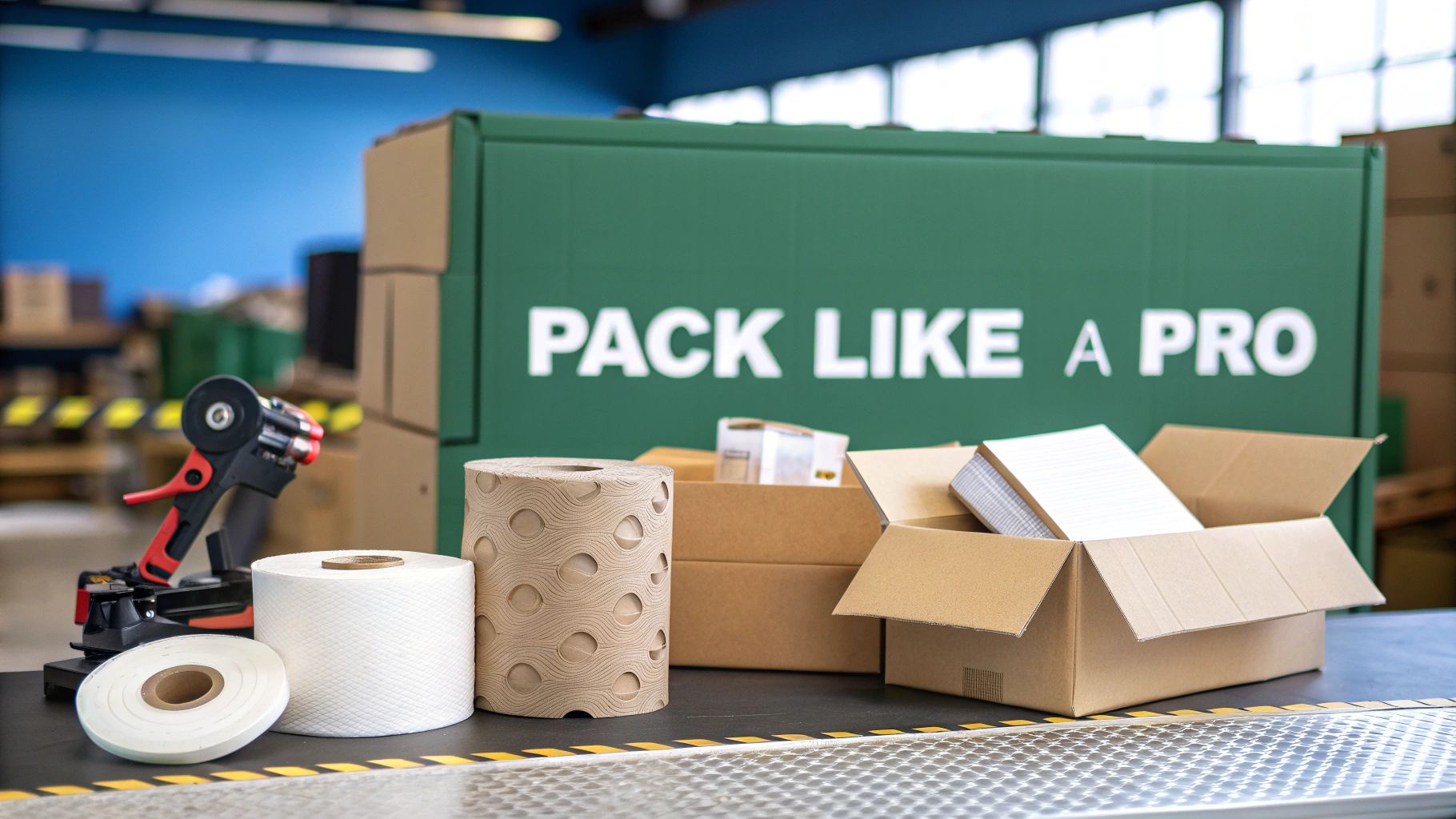Here’s a simple truth I’ve learned over years of helping people with storage and shipping: the way you pack a box is just as important as what’s inside it. If you get the basics right—a sturdy box, at least two inches of padding on all sides, and a solid seal with good packing tape—you’ve already won half the battle. This simple approach is your best defense against shipping mishaps.
Why Your Packing Method Matters More Than You Think
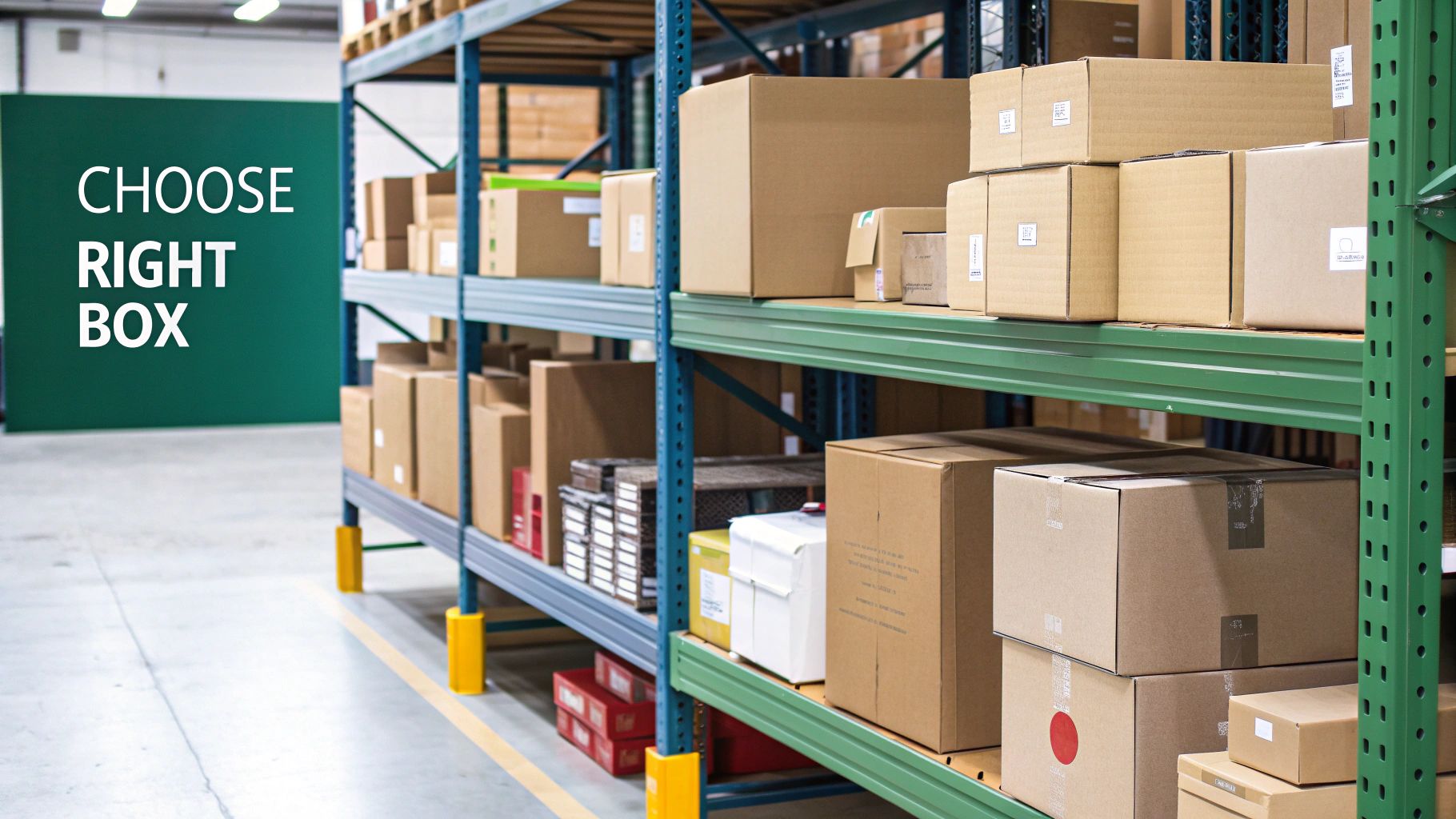
Getting something from point A to point B in one piece isn’t about luck. It’s all about strategy. Whether you're sending a care package across the country, returning that online purchase, or moving items into your Endless Storage unit, knowing how to pack a box properly is a skill you can't afford to skip.
A poorly packed box is just asking for trouble. Items can rattle around, break, or get completely crushed by heavier packages stacked on top during transit. We've all been there—the frustration of opening a box to find a shattered heirloom or a damaged product. For businesses, this is more than just an annoyance; it directly hits customer satisfaction and can tarnish a brand's reputation. In fact, some studies show that improper packing is behind as much as 30% to 40% of all product damage during shipping.
Your package is its own first line of defense against all the bumps, drops, and vibrations of a typical shipping journey. A well-packed box shows you care before it’s even opened.
This guide is designed to take the guesswork out of packing. We’ll walk you through everything you need to know to prepare your packages for whatever comes their way.
What This Guide Covers
We’re going to break down the art of packing into simple, manageable steps. You’ll get a clear roadmap covering all the essentials, including:
- Choosing the Right Gear: We’ll look at how to pick the perfect box, the best cushioning materials, and the right tape for the job.
- Mastering the Techniques: Learn the pro methods for wrapping, cushioning, and protecting everything from delicate glassware to a box full of heavy books.
- Sealing for a Secure Trip: Discover the right way to tape your box to give it maximum strength and keep it sealed tight until it reaches its destination.
By the time you're done, you'll have the confidence and know-how to pack any box like a seasoned expert, ensuring your belongings are safe and sound for the journey.
Choosing the Right Tools for a Secure Shipment
Before you even think about wrapping a single item, your first move should be setting up a proper packing station. I’ve seen it time and time again: successful shipping starts with having the right supplies on hand from the get-go.
Don’t just grab any old box from the garage. The foundation of a secure package is a high-quality, new corrugated box that’s actually rated for your item's weight. Trust me, using a flimsy, single-wall box for something heavy like a set of dumbbells is just asking for a blowout in transit.
The strength of your box is everything. For lighter items under 10 pounds, a standard new box will probably do the trick. For anything heavier or more fragile, you absolutely need to upgrade to a heavy-duty or double-wall corrugated box. That extra layer provides critical structural integrity and much-needed puncture resistance.
While shipping has its own unique challenges, many of the core packing techniques are similar to moving. You can check out our guide on how to pack a box for moving to see where the strategies overlap.
Cushioning and Sealing Materials
Once you've got the right box, your next focus is on what goes inside and how you seal it up. These elements are completely non-negotiable for protecting your shipment.
Your choice of void fill—the stuff that cushions your items—really matters. While bubble wrap is a classic for a reason, don't overlook other great options:
- Kraft Paper: This is my go-to for crumpling to fill empty space and for wrapping sturdy, non-fragile items. It’s also recyclable and very cost-effective.
- Air Pillows: Perfect for filling large gaps in your box without adding much weight, which helps keep shipping costs down.
- Foam Inserts: For high-value electronics or extremely delicate items, nothing beats custom-fit protection from foam.
To make sure you have everything you need, here's a quick checklist of the essentials.
Essential Packing Supplies Checklist
Having these items ready before you start packing makes the whole process smoother and far more effective.
The single most critical supply, in my experience, is your tape. You must use a pressure-sensitive packing tape that is at least two inches wide. Your craft tape or masking tape belongs in the art drawer—it simply lacks the adhesive strength to keep a box sealed through the bumps and tumbles of transit.
The packaging industry is a massive, growing field, currently valued at around $1.171 trillion, largely driven by the explosion of e-commerce. As more people expect their items to arrive safely and on time, investing in the right materials is no longer optional. A small investment in quality supplies directly translates into a successful, damage-free delivery.
Mastering The Art Of Cushioning And Protection
Protecting your items inside the box is a hands-on skill that really separates the amateurs from the pros. It’s all about creating a snug, shock-absorbent cocoon that stops things from shifting, rattling, or breaking during the inevitable bumps and tumbles of transit.
Think about the difference between packing a heavy book and a delicate glass vase. The book is pretty straightforward—it just needs a layer of kraft paper to prevent scuffs and enough filler to keep it from sliding around. But the vase? That requires a completely different, multi-layered strategy to survive the journey. If you're dealing with delicate goods, it’s worth reading up on how to pack fragile items like a pro before you even start.
This infographic lays out the methodical process you'll want to follow.
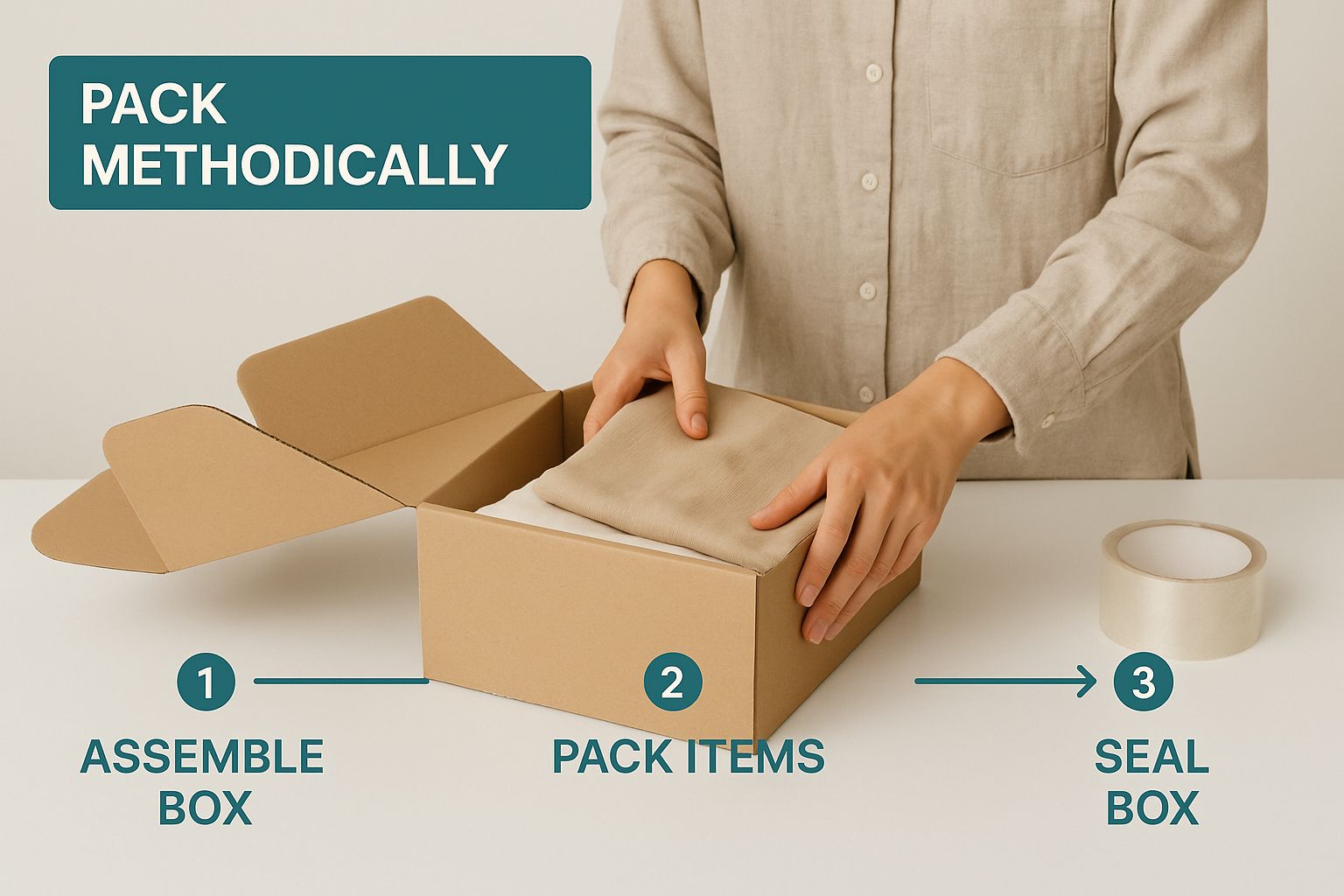
The biggest takeaway here is that effective packing isn't a rushed afterthought. It's a deliberate, step-by-step process.
The Two-Inch Rule And Individual Wrapping
Let the "2-inch rule" be your north star. Simply put, this means you need at least two inches of cushioning between your item and every single wall of the box—top, bottom, and all four sides. This buffer zone is your item's best line of defense.
Always start by wrapping each item on its own. For anything fragile, like ceramics or electronics, this step is absolutely non-negotiable.
- Wrap: Cover the item completely with a few layers of bubble wrap.
- Tape: Use packing tape to secure the wrap so it doesn’t come undone. Just be sure not to tape directly onto the item’s surface.
- Position: Place the fully wrapped item right in the center of your cushioned box.
This exact principle is crucial when you’re packing up a kitchen. For more specific advice, our ultimate guide on how to pack dishes has detailed techniques you can put to use right away.
The Box-In-A-Box Method For Ultimate Safety
When you have something extremely fragile or valuable, the box-in-a-box method is the gold standard for protection. It’s exactly what it sounds like. After you’ve packed your item into its main box using the 2-inch rule, you place that entire box inside a second, larger shipping box.
Next, you fill the space between the inner and outer box with another two inches (or more) of cushioning material, like packing peanuts or crumpled kraft paper. What you're doing is creating a secondary suspension system, which offers incredible protection against shock and vibration. It’s an essential technique for those items that absolutely must arrive in perfect condition.
Secure Sealing and Labeling for Flawless Delivery
Even a perfectly cushioned item is at risk if its box decides to pop open mid-journey. Getting the seal right isn’t just about closing the flaps; it’s about fortifying the box’s entire structure for the rough and tumble of transit. This is the final step that makes all your careful packing work count.
I’ve seen it all, and the most reliable technique, hands down, is the H-taping method. This simple approach secures every potential weak point on the top and bottom of your box, leaving nothing to chance.
You start by running a long strip of high-quality packing tape right down the center seam where the main flaps meet. Then, you tape across the two shorter seams on each end. This creates a bold “H” shape, giving the box maximum structural integrity.
Don't be stingy with the tape. I can't tell you how many times I've seen a shipment fail because someone tried to save a few pennies on tape. It's a false economy. Make sure you’re using a pressure-sensitive packing tape that's at least two inches wide for a dependable hold. While a lot of packing skills are the same for moving, the unique stresses of the shipping world demand this extra security. If you're curious about the differences, check out our ultimate guide on how to pack moving boxes.
Labeling for a Smooth Journey
With your box sealed tight, it's time to give it clear directions. How you place and protect the shipping label is critical for both the automated sorting machines and the delivery drivers who will handle it.
Your shipping label should always go on the largest, flattest surface of the box. Do your best to avoid placing it over any seams, edges, or on top of your packing tape. Any of those things can create wrinkles or reflections that interfere with a scanner's ability to read the barcode.
Pro Tip: Before you seal the box, always toss a duplicate packing slip or even just a piece of paper with the sender and recipient's addresses inside. If the main label gets ripped off or becomes unreadable, this simple backup can be the one thing that saves your package from the lost-and-found abyss.
Finally, give your box a quick once-over. If you're reusing a box, you absolutely must remove or completely cover up any old shipping labels, barcodes, or addresses. Grab a black marker and go to town—you want to thoroughly obscure any old information to prevent confusion at the sorting facility. A single, clear destination is the key to a flawless delivery.
How to Handle Special and International Shipments
Let's be honest: not all shipments are created equal. Knowing how to pack a standard box is one thing, but that all changes when you’re dealing with international destinations, heavy items, or just plain awkward shapes. These scenarios demand a smarter, more robust strategy right from the get-go.
Think about it. An international shipment means your package is in transit for much longer, getting handled by more people, and has to clear customs. This isn't the time to cut corners. You have to be extra diligent with both your packing and your paperwork.
Navigating Cross-Border and Complex Shipments
When you're prepping a package for an overseas journey, durability is everything. Always, and I mean always, start with a new, double-wall corrugated box. A used box just won't have the same structural integrity for a long trip. Make sure you seal all the seams using the H-taping method and pack your cushioning materials tightly so nothing shifts.
And don't forget about customs. Officials might need to open your box for inspection, so pack it in a way that’s easy for them to look through and, more importantly, put back together correctly. Be crystal clear when listing all the contents on the customs forms to avoid frustrating delays.
For those other tricky situations, like shipping liquids or something with a bizarre shape, a few specific tactics will save you a headache:
- Liquids: The key here is containment. First, put the liquid in its own sealed container. Then, put that container inside a leak-proof bag. Only then should it go into your shipping box, surrounded by absorbent material like paper towels or pads.
- Heavy Items: For anything over 25 pounds, you absolutely need a double-wall box. I'd even suggest adding some interior cardboard supports to keep the box from bulging or caving in under its own weight.
- Odd Shapes: Your goal is to transform that awkward item into a predictable, cube-like package. Use plenty of filler and even some custom-cut cardboard pieces to build a stable, rectangular outer shell around the item.
A lot of these advanced techniques are really just extensions of the basics. If you need a quick refresher, check out our guide on how to pack efficiently for moving—many of the core ideas are just as useful here.
The single most important mindset for special shipments is to plan for the absolute worst-case scenario. Assume your package will be dropped, delayed, and opened. If you pack for that possibility, you give it the best possible chance of arriving safe and sound.
Proactive Tips for Modern Shipping Hurdles
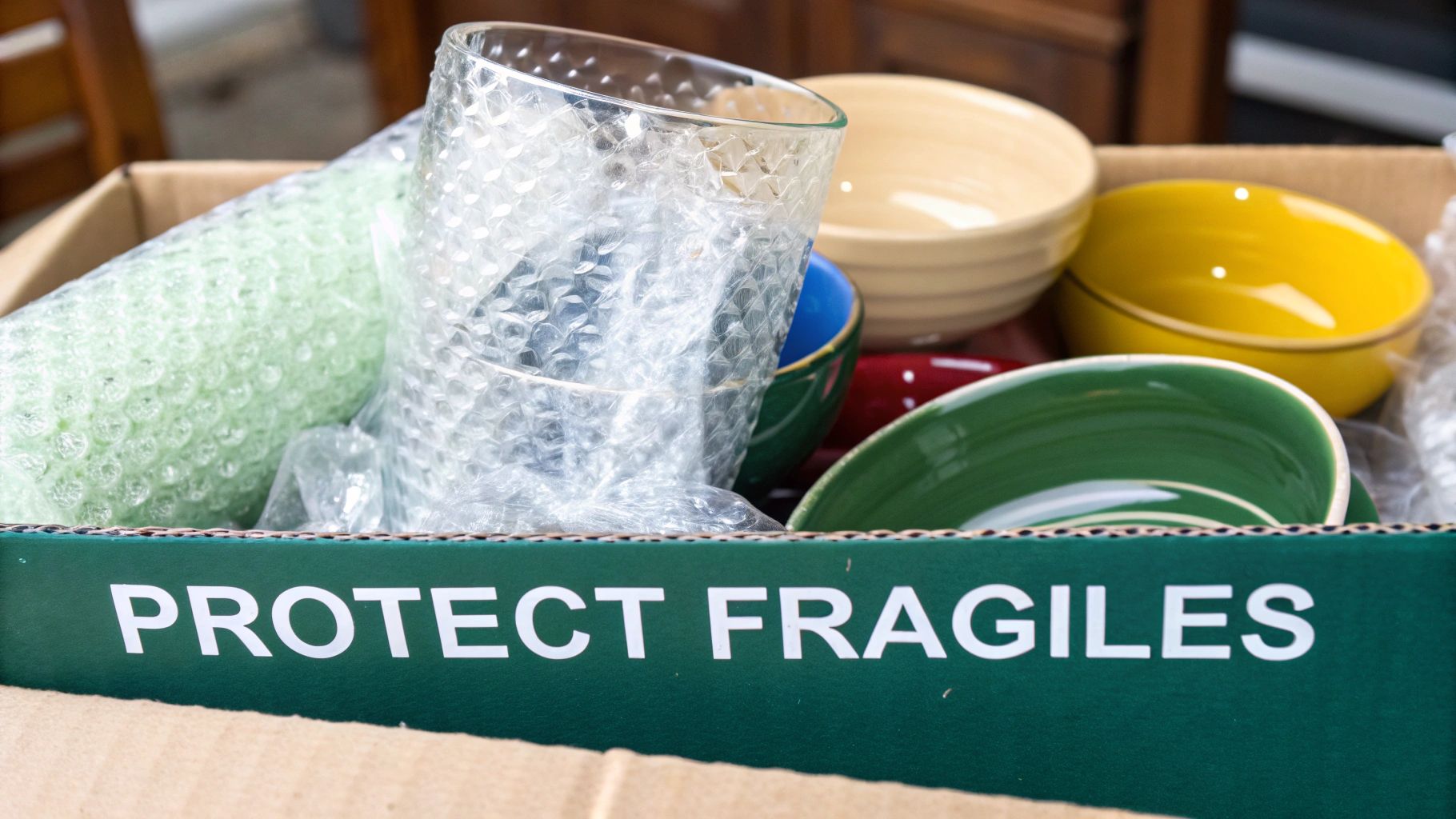
Here's the thing: even a perfectly packed box eventually leaves your hands and enters the wild world of modern logistics. Knowing how to pack a box for shipping is your absolute best defense. It prepares your items for those frustrating but common hurdles, like port congestion or transit delays that can tack days—or even weeks—onto a journey.
Think of your sturdy, well-cushioned box as its own little insurance policy. You’re building it to withstand not just the usual bumps and tumbles, but also the extra handling and prolonged stress that come with supply chain hiccups. When a package sits in a warehouse longer than anyone planned, that meticulous packing job becomes even more important.
Navigating Global Trade and Insurance
The global shipping landscape is always in flux. Shifting trade policies and container availability can have a direct impact on your delivery timelines. For instance, ocean carriers are constantly adjusting capacity to meet demand, and they plan to significantly increase it on major trade lanes. These dynamics just reinforce why you need packaging that can endure a truly unpredictable journey. You can discover more insights about these industry shifts on berlinpackaging.com.
This is also where shipping insurance really proves its worth. For anything valuable or sentimental, it offers a financial safety net against loss or damage.
When to Get Insurance: I always tell people to get insurance if the thought of replacing the item out-of-pocket makes them wince. It’s a small price to pay for genuine peace of mind.
Most carriers offer what's called "declared value coverage," but you absolutely have to read the fine print. I've seen cases where policies won't cover damage if they decide the packaging was insufficient.
This brings us right back to where we started: your best protection is proper packing. Especially for delicate items, your packing method is your first and most important line of defense. Our guide on how to pack fragile items provides a detailed look at the specialized techniques you’ll need for those extra-sensitive shipments.
Got Packing Questions? We’ve Got Answers.
Even after you've mastered the basics of how to pack boxes for shipping, some specific questions always seem to pop up. Trust me, I've heard them all. Getting these little details right can be the difference between a smooth delivery and a major headache, so let's clear up a few of the most common ones.
Can I Reuse An Old Shipping Box?
You absolutely can, but you have to be smart about it. Reusing a box is a fantastic way to save a little money and be kinder to the planet, but only if that box is still in great shape.
Before you even think about putting something inside, give it a good, hard look. The cardboard should feel completely stiff. Check for any punctures, water stains, or corners that look even slightly crushed. Any of those are deal-breakers. A compromised box just won't protect your stuff. One more critical step: you must completely cover or black out all old shipping labels and barcodes. Otherwise, you risk confusing the automated sorting machines at the shipping facility.
Here's my rule of thumb: if you have any doubt at all about a box's strength, just grab a new one. The few bucks you save aren't worth the cost of replacing what's inside.
What Is The Single Biggest Packing Mistake?
Easy. Leaving empty space in the box. It’s hands-down the most frequent and most destructive mistake people make. Even a tiny bit of wiggle room allows your items to shift, slide around, and bang against the sides during transit. That movement is almost always what causes damage.
Your goal is to make everything inside totally immobile.
- Fill every nook and cranny. Use crumpled kraft paper, air pillows, or bubble wrap to fill any and all gaps.
- Give it a shake. After you’ve taped it up, gently shake the box next to your ear. You shouldn't hear or feel a single thing moving. If you do, open it back up and stuff in more filler material.
How Do I Pack Multiple Items In One Box?
Packing a few things together is all about strategy. You have to think like a puzzle-master, making sure nothing can harm anything else on the trip.
First, wrap each item individually, treating it as if it were being shipped all by itself. Then, place the heaviest thing you have right in the bottom center of the box. Arrange the lighter items around it and on top. It’s crucial to use cardboard dividers or extra padding between every single piece to create a buffer. Nothing should be touching directly. When you isolate each item like this, you give them all the best chance of arriving in one piece.
When you're ready to store your belongings with the same level of care you use for shipping, Endless Storage makes it simple and secure. We bring the boxes, handle the pickup, and keep your items safe in our climate-controlled facilities. Get started with Endless Storage today.
Frequently Asked Questions
Unveiling the Secrets to Effortless Storage
Endless Storage is available nationwide. You pick a plan, tell us where to pickup, and we'll send a UPS van to collect, whichever state you're in.
Your shipping label will be sent to your email within a few minutes, if not instantaneously. It can also be accessed through your customer profile.
Your box will be shipped to one of our climate controlled self storage facilities in our closest self storage facility. Our manager will accept your package, notify you that your box has been received, and securely stored. Only our managers will have access to Endless Storage boxes.
Email us at admin@endless-storage.com click to live chat with us, or send us a message below.
Never! We're committed to transparent pricing with no surprises. You'll lock in your rate with no hidden fees and no long-term contracts.
Fast access guaranteed! Your boxes will arrive at your doorstep within 48 hours of requesting them back. Need to check on delivery? We provide tracking information for complete peace of mind.
Totally flexible! Store month-to-month with no long-term commitment and cancel anytime.
Everything's online! Use your account dashboard to:
• Set up automatic monthly payments
• Request box returns
• Update your address
• Order additional boxes
• Track shipments
Your boxes are insured up to $100 each. Our customer service team will help you file any necessary claims and resolve issues quickly.
Don't worry – we'll email you right away if there's a payment issue. Your items stay safe, though you may have temporary service interruption or late fees until payment is resolved.
When you request our free storage kits, you'll have 30 days to send in your boxes to activate your 3 months of free storage. Think of it like starting a gym membership – your activation window begins when you receive your kits, and your full free trial begins once you send in your first box. During your free months, you'll experience our complete storage service at no cost.
Your 30-day activation window begins when you receive your storage kits. We'll send you an email confirmation when your kits are delivered, marking the start of your activation period.
If you haven't sent any boxes for storage within your 30-day activation window, your free trial will expire and we'll begin charging the regular monthly rate of $9.99 per box. This helps ensure our storage kits go to customers who are ready to use our service.
A box costs $9.99 per month to store (plus sales tax). This price includes free shipping for standard boxes under 50 lbs. and smaller than 16"x16"x16"
Log into your Endless Storage account, locate the box you would like returned, and simply click Return My Box.
Yes, each box stored with us is insured for up to $100 throughout transit as well as the duration of storage within our facilities.
Your box will be at your doorstep within 48 hours of you requesting it back.
Store 10+ boxes? We'll pick them up for free! After your purchase, we'll contact you to schedule a convenient pickup time and arrange UPS collection.
We trust UPS with all shipments, and every box includes $100 insurance coverage. You'll receive tracking information to monitor your items' journey.
Yes! Visit any of our locations by appointment. Just bring a photo ID matching your customer profile.
For everyone's safety, we can't store hazardous materials, firearms, or perishables. All items must fit within our standard boxes.
It's easy! Order your storage kit online, and we'll ship it to you within 1-2 business days. Your shipping labels will be emailed instantly and available in your account.
We're here to help! Email us at admin@endless-storage.com, use our live chat, or send us a message through your account.
To cancel your storage service with Endless Storage, please email your cancellation request to admin@endless-storage.com. Our team will process your request within 2 business days and confirm your cancellation via email.
We understand packing takes time. However, to maintain your free trial benefits, you'll need to send at least one box within the 30-day activation window. If you need more time, you can always start with one box to activate your trial and send the rest later. You can always reach out to admin@endless-storage.com if you have any issues or concerns.
When you request our free storage kits, you're starting a 30-day window to begin using our storage service.
To avoid any charges, simply send at least one box for storage within 30 days to activate your 3-month free trial. If you decide not to use our service and don't send any boxes within the 30-day window, a one-time $50 fee will apply to cover the costs of materials and shipping. This helps ensure our storage kits go to customers who are ready to use our service.
Think of it like reserving a hotel room – we're setting aside space and sending specialized packing materials for your use. The fee only applies if you request materials but don't begin storage, similar to a hotel's no-show charge.
